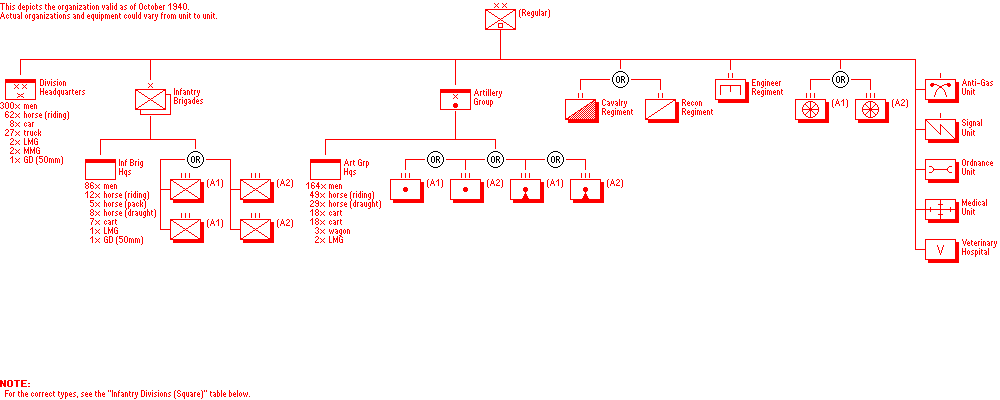| World War II Armed Forces — Orders of Battle and Organizations | Last Updated 15.10.2014 |

|
This depicts a typical organization. As can also be seen from the diagram above, actual organizations and equipment could vary
from division by division. The square (four infantry regiment) infantry division was being gradually phased out by late 1941.
On paper, this type of division had about 25,000 men.
But the divisions were seldom as neat and tidy as the diagram above.
Elements were consistently being attached or detached, so that some divisions had as few as 17,000 men
and some as others as many as 32,000.
The units in the divisions did not not always have the same size or configuration. A typical example would be the reconnaissance "regiment". In some divisions this was a cavalry-motorized battalion, in others it was a battalion-sized unit of horse cavalry, and in some divisions a reconnaissance element was missing altogether. The artillery also suffered variations — in one case (19th Infantry Division) even having two regiments — some being equipped with different types and numbers of guns. The size of the Transport Regiment also tended to vary, depending on the mission assigned to the division, and whether the regiment itself was horse-drawn, partially or wholly motorized. For example, the transport regiment of the 18th Motor Division had one horse-drawn company and three truck companies. In the process of converting these divisions to the triangular (three infantry regiment) organization, one brigade headquarters and an infantry regiment might be withdrawn from the division and operate indepndently, with the appropriate support units attached. In case the separation was permanent, the remaining brigade headquarters would be reconfigured and redesignated as the infantry group headquarters. |
| Infantry Divisions (Square) | |||||||||||||||||
| (Type) | Division
Commanding General |
Raised | Infantry | Artillery | Recon Unit |
Engineer Rgt |
Transport | Other Units |
Notes | ||||||||
| (Type) | Brig | Inf Rgts | Brig | Inf Rgts | (Type) | Grp | Art Rgt | Equipment | (Type) | Rgt | |||||||
| (A) | 3
LTG Fusataro TOYOSHIMA |
14.05.1881 | (A1) | 5 | 6 68 |
29 | {18} 34 |
(A1) | — | 3 Fld | 36× 75mm | 3 Cav | 3 | (A1) | 3 | 3 | |
| (A) | 5 (motorized)
LTG Masao WATANABE |
14.05.1881 | (A1) | 9 | 11 {41} |
21 | 21 42 |
(A1) | — | 5 Fld | 24× 75mm 12× 105mm |
5 Recon | 5 | (A1) | 5 | 5 | [1][3] |
| (S) | 13
LTG Eitaro UCHIYAMA |
10.09.1941 | (S) | 26 | {58} 116 |
103 | 65 104 |
(S) | — | 19 Mtn | 36× 75mm | 13 Cav | 13 | (S) | 13 | 13 | |
| (S) | 18 (motorized)
LTG Renya MATAGUCHI |
10.09.1941 | (S) | 23 | 55 56 |
35 | 114 {124} |
(S) | — | 18 Mtn | 36× 75mm | 22 Recon | 12 | (S) | 18 | 18 | [2][3] |
| (A) | 19
LTG Yoshio KOZUKI |
24.12.1915 | (A1) | 37 | 73 {74} |
38 | 75 76 |
(A1) | 19 | 15 Fld 25 Mtn |
8× 150mm 36× 75mm |
19 Recon | 19 | (A1) | 19 | 19 | |
| (A) | 20
LTG Hisashige NAGATSU |
24.12.1915 | (A1) | 39 | {77} 78 |
40 | 79 80 |
(A1) | 20 | 26 Fld | 36× 75mm | 20 Recon | 20 | (A1) | 20 | 20 | |
| (S) | 110
LTG Mamoru IINUMA |
16.06.1938 | (S) | 108 | 139 {140} |
133 | 110 163 |
(S) | — | 110 Fld | 36× 75mm | 110 Cav | 110 | (S) | 110 | 110 | |
| (S) | 116
LTG Toshijiro KEUCHI |
15.05.1942 | (S) | 119 | 109 120 |
130 | 133 {138} |
(S) | — | 122 Fld | 36× 75mm | 120 Cav | 116 | (S) | 116 | 116 | |
|
Notes:
Type (A) are regular, peacetime (activated) units. Type (S) are wartime (activated) units. Infantry regiments in {curly brackets} are those lost during triangularization. [1] But: 2nd Hygiene and Water Supply Department. Included the Tank Unit, 5th Division. [2] The 35th Infantry Brigade with 124th Infantry Regiment operated independently as Kawaguchi Detachment, and was still at Camranh Bay.
[3] A standard, (non-motorized), divison had approximately 200 trucks.
Only the 5th (860 trucks) and 18th divisions were motorized square divisions.
The scarce trucks were for moving the heavy equipment and the artillery,
and soldiers not allocated places in motor vehicles were issued bicycles.
| |||||||||||||||||